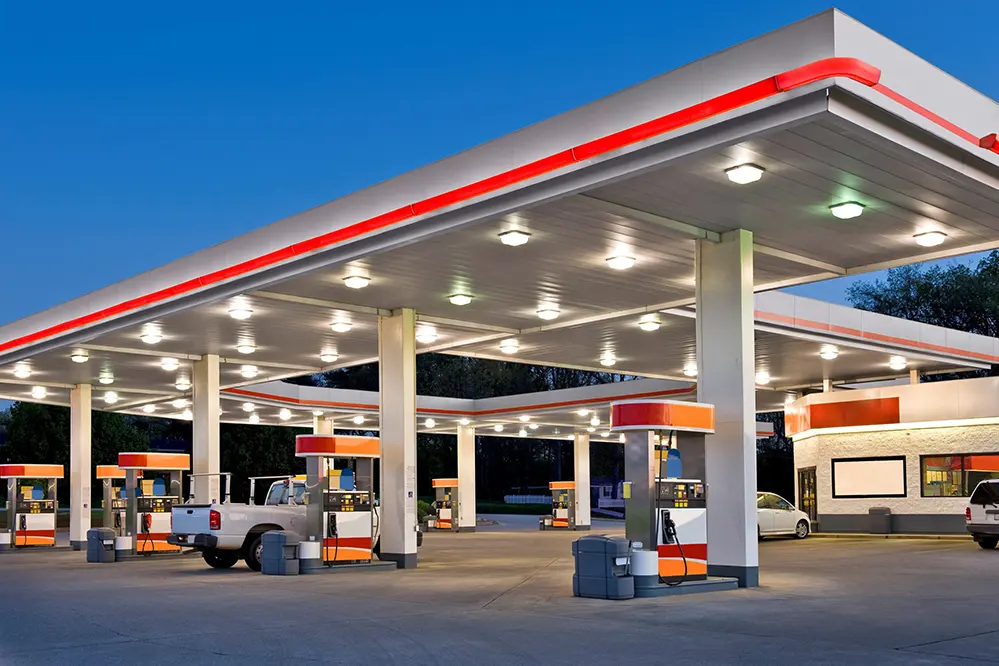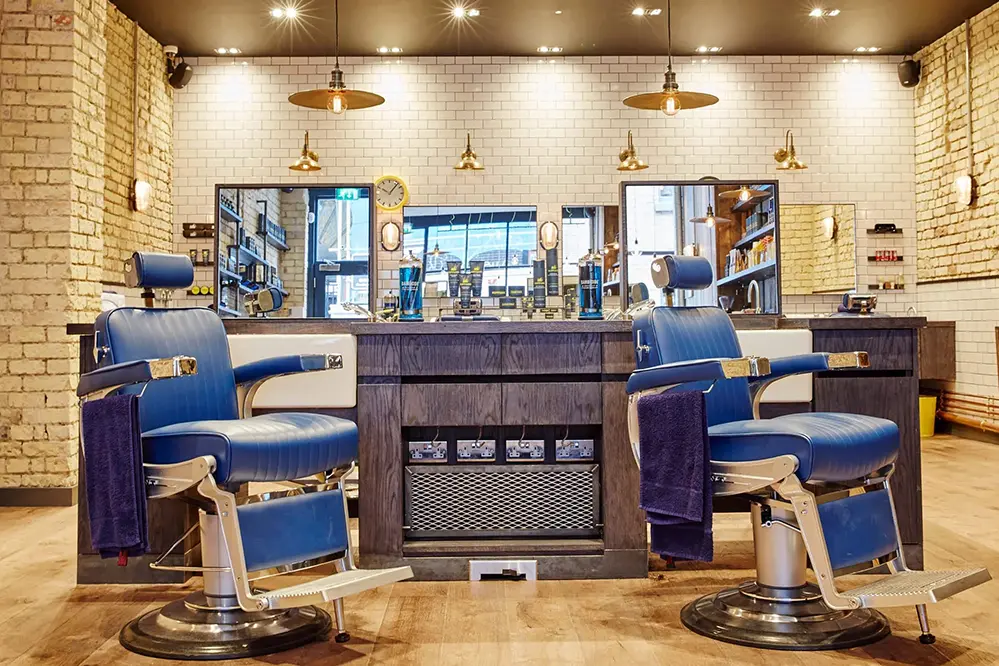In the competitive landscape of fuel retail, understanding how to choose lighting for gas stations is more than a mere operational decision—it’s a strategic move that can significantly impact customer experience and business success. Imagine driving late at night, the road stretching endlessly before you, when suddenly, a well-lit gas station emerges from the darkness, offering not just fuel but a sense of security. This scenario underscores the importance of selecting the right lighting, which can transform a gas station into a welcoming oasis for weary travelers.
Lighting is not just about visibility; it’s a powerful tool that enhances safety, reduces energy consumption, and boosts sales by attracting more customers. According to the National Association of Convenience Stores, well-lit gas stations can increase customer traffic by up to 20%. This statistic highlights the profound influence that thoughtful lighting choices can have on a business’s bottom line. Moreover, effective lighting can deter crime and create an inviting atmosphere that encourages repeat visits, making it a crucial element in the overall customer experience.
As you embark on the journey to illuminate your gas station effectively, this article will guide you through the key considerations and innovative solutions available. From energy efficiency to aesthetic appeal, we will explore the multifaceted aspects of lighting that can elevate your station to new heights of excellence. Continue reading to discover how the right lighting can transform your gas station into a beacon of safety, efficiency, and customer satisfaction.
Understanding Gas Station Lighting Needs
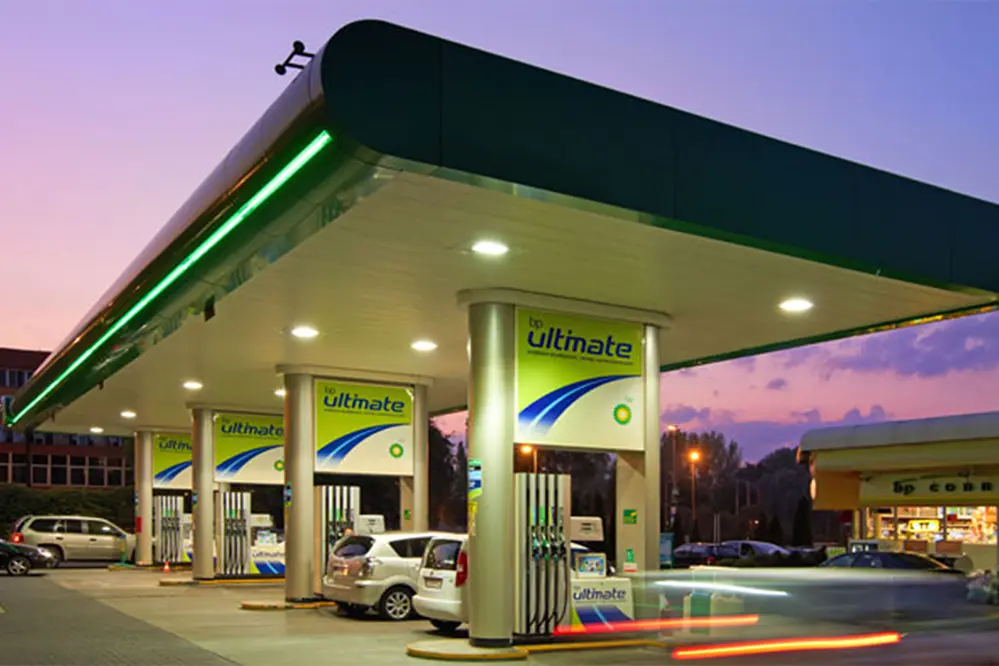
Identifying the specific lighting requirements for a gas station is the foundation for a successful implementation plan.
In the realm of gas stations, strategic illumination is essential for safety, security, and functionality. It not only improves visibility but also boosts customer confidence, encouraging repeat business.
Thus, it’s crucial to recognize that each station’s environment is unique, necessitating a tailored approach to lighting design, one that encompasses the high-traffic areas, pump islands, and potential blind spots.
Forecasting the impact of light on both employees and customers, it becomes clear that prioritizing areas that see the most activity isn’t merely about visibility but also about ensuring the safety, comfort, and efficiency of these critical zones.
This understanding will empower you to make informed decisions, combining aesthetics with functionality to create a welcoming and secure environment.
Importance of Proper Lighting
Proper lighting at a gas station isn’t merely an aesthetic consideration; it plays a crucial role in safety, security, and customer satisfaction, making it an undeniable core aspect of operations.
The gas station’s lighting directly impacts the customer experience, aiding navigation and ensuring their safety while refueling.
Effective lighting solutions must balance energy consumption with performance, presenting a unique blend of aesthetic appeal and operational excellence, ensuring the site appears welcoming, secure, and attractive to potential customers.
Ultimately, the strategic placement of lights can be the defining factor in creating a gas station environment that transforms casual visits into a seamless, comfortable, and efficient customer journey, while also serving as a deterrent to potential security threats. This thoughtful illumination strategy allows stations to “shine” in operational effectiveness and customer service excellence.
Types of Lighting Solutions
In the realm of gas station illumination, selecting top-tier lighting solutions is paramount. Each type carries distinct advantages, providing not just brightness but resonance with the station’s ambience, energy efficiency, and environmental considerations.
LED technology, for instance, offers impressive energy savings (up to 70%) compared to traditional solutions, making it an excellent investment in sustainability and long-term savings. Meanwhile, advanced control systems allow dynamic adjustments, enhancing both security and operational flexibility.
Compact “under-canopy” and “over-island” lights are particularly effective for areas of high activity.
LED Lighting Benefits
LED lighting has revolutionized gas station illumination, providing a fusion of functionality, aesthetic appeal, and sustainability. These luminaires offer remarkable longevity, significantly reducing the maintenance intervals and associated costs.
With energy efficiency at the forefront, LEDs consume considerably less power, translating to substantial cost savings. This efficiency, coupled with their robustness in diverse weather conditions, ensures reliability and consistent performance over time.
LEDs cut electricity consumption by up to 70%, offering a compelling case for energy-conscious businesses.
Furthermore, the adaptability of LED fixtures enables tailored lighting solutions that enhance visibility and safety, crucial for both patrons and employees. By investing in LED lighting, gas stations can create inviting environments that prioritize customer satisfaction and operational excellence, all while contributing positively to environmental conservation efforts.
Fluorescent Lighting Considerations
Fluorescent lighting has long been a staple in commercial spaces, offering an economical option for broad illumination.
Despite their declining popularity, fluorescent fixtures have a place in gas station lighting, particularly for those not yet ready to transition to LEDs. They traditionally offer a good balance of brightness and affordability, which can be advantageous for small-scale operations aiming to manage initial costs. One noteworthy advantage of fluorescent lights is their ability to provide evenly distributed light, particularly beneficial in areas where uniform visibility is necessary.
However, these fixtures do face certain challenges that must be considered. Inconsistent performance in colder temperatures, coupled with potential flickering issues, can affect the overall lighting quality, impacting both customer experience and operational efficiency, particularly during the night.
When contemplating fluorescent options, professionals should assess the specific needs of their gas stations, bearing in mind the technological advancements influencing today’s market. Understanding these nuances can empower decision-makers to choose lighting that not only serves immediate needs but also aligns with broader energy-saving and environmental goals.
Energy Efficiency and Cost Savings
Choosing energy-efficient lighting for your gas station is pivotal for realizing substantial cost savings and boosting profitability.
LED lighting, an exemplary energy-efficient choice in the current market, enhances visibility while substantially reducing energy consumption. These lights not only cut down electricity bills but also lessen the environmental impact, aligning with sustainable business practices. By utilizing advanced LED technologies, gas station owners can dramatically curtail maintenance costs due to their prolonged lifespan.
Furthermore, LEDs offer the benefit of a consistent luminous output that remains unaffected by temperature fluctuations. This resilience ensures that your station remains well-lit under varying climatic conditions, thereby guaranteeing customer satisfaction and optimizing operational efficiency without additional financial burdens.
Ultimately, for those in the industry who seek to maximize their ROI and foster environmental stewardship, investing in energy-efficient lighting solutions is a strategic move forward. This proactive choice secures an unparalleled opportunity to transform significant overhead costs into enduring financial gains, simultaneously contributing to a greener, more sustainable future for your operations.
Safety and Security Enhancements
When considering how to choose lighting for gas stations, enhancing safety and security should be a top priority.
Strategically, an effective illumination plan is a formidable deterrent against crime and accidents, ensuring both patrons and employees feel secure. Well-lit environments elevate the visibility within the premises, particularly in high-traffic areas and during nighttime operations. This increased visibility not only discourages illicit activities but also reduces the likelihood of accidents, fostering a safer environment.
Moreover, lighting should be part of a comprehensive security system at your location. By incorporating surveillance cameras, the quality of footage captured can greatly benefit from enhanced lighting, aiding in quick resolution of any security incidents and reassuring both customers and employees of a secure setting.
Finally, adopting cutting-edge lighting solutions to bolster safety doesn’t merely boost the aesthetics; it translates into tangible business advantages as well. Customers will likely frequent a place where they feel secure, driving up customer satisfaction and loyalty. Untangling safety concerns allows you to focus on delivering superior service, propelling your business towards sustained growth and unfaltering success.
Aesthetic Appeal and Branding
Lighting is crucial for establishing brand identity.
Your gas station’s aesthetic appeal is not just about looks. The right lighting can forge a visual synergy that seamlessly converges aesthetics with functionality, making an indelible impression on passing motorists. Dim yet elegant lights should echo the ethos of sophistication or adventure, whatever your brand represents.
Consider the interplay of colors and shadows.
Opt for lighting solutions that resonate with – if not elevate – your brand’s unique characteristics by harmonizing vibrant hues or sleek designs with your brand’s narrative, creating an inviting presence that tempts customers to explore more.
Incorporating advanced lighting technology offers remarkable opportunities for enhancing brand image, highlighting key elements like logos or promotions. This strategic application can enhance aesthetic allure while reinforcing brand recognition, situating your station as a memorable landmark of the community.
Environmental Impact of Lighting Choices
Selecting the optimal lighting for your gas station goes beyond visuals, seamlessly intertwining aesthetics, energy efficiency, and environmental stewardship into a cohesive strategy. This multifaceted approach aims to enhance both consumer experience and ecological mindfulness.
Choosing energy-efficient lighting is pivotal for reducing carbon footprints and is crucial for boosting sustainability efforts.
LEDs, compact fluorescent lamps, and smart systems provide superior illumination options, minimizing waste (both energy and environmental) and emissions.
These choices lead to lowered operational costs while supporting environmental legislation and green building initiatives, reducing unnecessary energy consumption.
Such selections offer an unparalleled opportunity to simultaneously elevate brand image and embrace corporate social responsibility by implicitly endorsing environmental sustainability as a core value of your company.
Altogether, being mindful of your station’s commitment to eco-friendly practices. Through innovative lighting solutions, you not only illuminate pathways but also pave the way toward a brighter, sustainable future.
Compliance with Local Regulations
Navigating the intricate landscape of local regulations is crucial when choosing lighting for a gas station. Understanding the nuanced requirements that govern illumination intensity and placement will ensure that your station operates legally and efficiently. By embracing regulatory compliance, you transform potential challenges into opportunities for innovation and growth.
Adherence to these regulations isn’t merely a legal necessity; it’s a testament to your commitment to safety, environmental responsibility, and community relations. These standards typically cover aspects such as light trespass control, glare reduction, and energy efficiency requirements, ensuring that your lighting solutions harmoniously integrate with their surroundings and enhance overall safety.
Strategically, compliance serves as a cornerstone of your lighting initiative. By aligning with these local mandates, you proactively mitigate the risks of potential fines or legal complications, thus safeguarding your investment while positioning your enterprise as a responsible community stakeholder.
Ultimately, a thorough understanding of compliance requirements not only elevates your station’s operational standards but also inspires confidence in your clientele. Anticipating and incorporating regulatory demands equips your business with resilience, simultaneously lighting a path toward sustained development and fostering a collaborative relationship with the regulatory bodies that shape the industry landscape.
Placement of Light Fixtures
Thoughtful placement of light fixtures is imperative to optimize visibility and security at your gas station. Balancing ambient and task lighting ensures that all areas, from fueling stations to walkways, are adequately illuminated. This deliberate distribution minimizes shadow areas and enhances the customer experience.
In particular, canopy lights must be strategically placed to illuminate fueling areas efficiently. Fixtures should be positioned to provide a seamless spread of light, reducing glare and ensuring fuel pumps are well-lit without casting disruptive shadows on vehicle dashboards.
The terms “over-illumination” and “under-illumination” often encapsulate the delicate balance of achieving the ‘Goldilocks illumination.’
Canopy Area Lighting
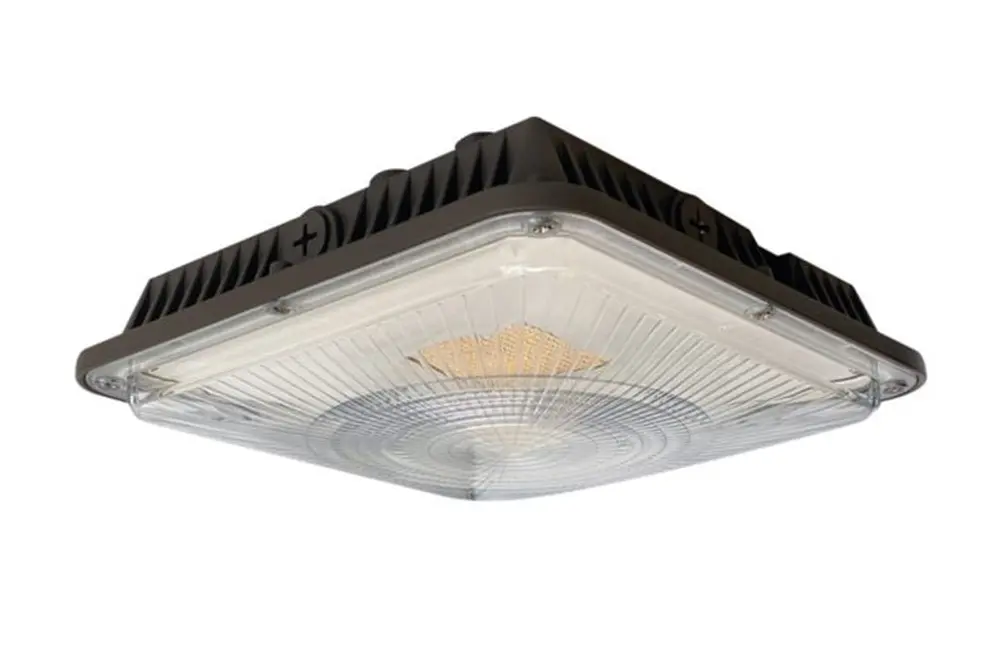
Effective canopy area lighting is critical for ensuring safety, seamless operations, and a welcoming environment at any gas station.
- Assess Lighting Requirements: Evaluate the necessary illuminance to provide optimal visibility for drivers and pedestrians.
- Choose Energy-Efficient Options: Opt for LED lighting to reduce energy consumption and financial expenditure.
- Focus on Uniform Distribution: Ensure lights are evenly spaced to minimize shadows and enhance the overall user experience.
- Prioritize Durability: Select fixtures designed to withstand environmental conditions, reducing maintenance costs long-term.
- Consider Compatibility: Ensure lighting fixtures integrate well with existing systems for both aesthetics and functionality.
By maintaining these considerations, canopy lighting can significantly enhance safety and aesthetic appeal.
Adopting a forward-thinking approach not only elevates customer satisfaction but also exemplifies a commitment to sustainability and innovation.
Forecourt and Parking Lot Lighting
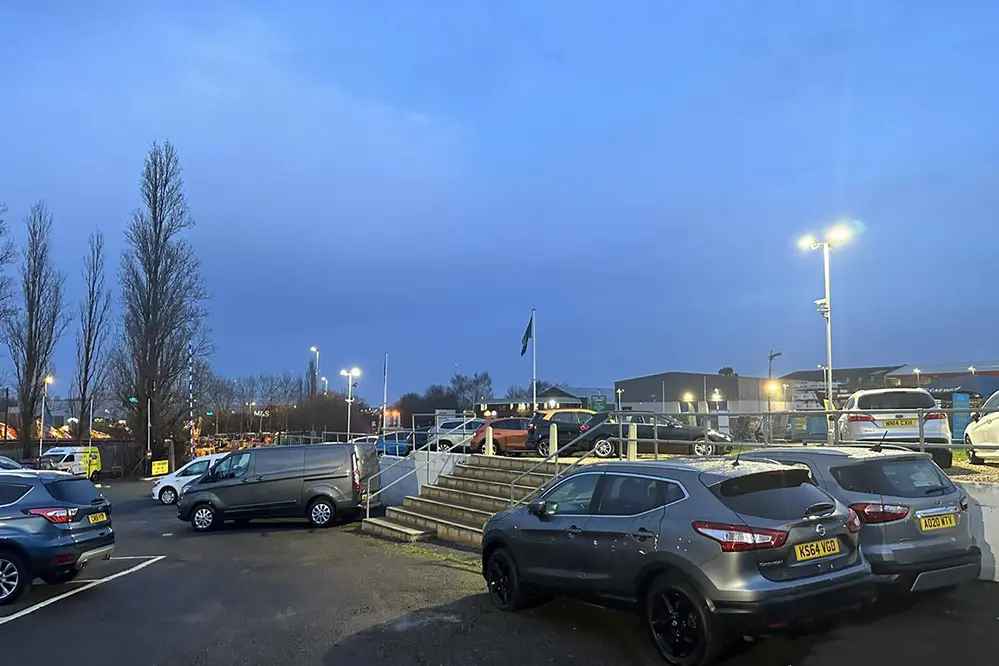
Illuminating the forecourt is crucial for safety.
The right lighting strategy in this area enhances security and convenience. It’s essential to achieve a balance between sufficient illumination and energy efficiency, focusing on areas where vehicles and pedestrians interact. Additionally, consider the use of motion sensors to optimize energy usage during low traffic periods.
Efficient lighting improves visibility dramatically.
LED lights are the pinnacle choice for this application—they provide crisp brightness that cuts through environmental obscurities, such as fog or rain—and their extraordinary longevity reduces replacement needs.
This investment significantly boosts nighttime safety while fostering an inviting ambiance. With advancements in lighting technology expected to progress beyond new year, integrating smart lighting controls can further bolster efficiency, adapting to real-time conditions. These innovative systems not only ensure continual operational excellence but also underscore a gas station’s advanced commitment to customer and environmental stewardship.
Maintenance and Durability
Selecting lighting that stands the test of time is a critical aspect of gas station operations.
In an industry where the pace is relentless, minimizing maintenance while maximizing durability is an opportunity not to be overlooked. High-quality LED fixtures, known for their robust build and long lifespan, help ensure consistent performance and reduce frequent replacements, which can be costly and disruptive.
It’s not just about how long the lighting lasts; it’s about ensuring seamless operation as environmental conditions shift. Premium lights designed to withstand elements like extreme temperatures and moisture protect your investment and reputation as a forward-thinking business. Such lights illuminate efficiently, come rain or shine, enhancing the overall customer experience.
Incorporating lights with easy access for maintenance further exemplifies strategic foresight. This feature facilitates quick, effective upkeep, minimizing downtime and maintaining safety and functionality. Consider fixtures that offer smart diagnostics to preemptively address potential malfunctions.
By prioritizing these aspects, you can establish a resilient lighting solution that ensures enduring reliability, even in demanding conditions.
Choosing the Right Lighting Supplier
The right partner will be transformative in this endeavor.
Selecting your lighting supplier is not just about procurement. The ideal supplier not only provides top-tier products but also plays a pivotal role in delivering exemplary service, from initial consultation to ongoing support. Therefore, it’s crucial to emphasize experience, responsiveness, and a proven track record of excellence when evaluating potential suppliers.
Seek professionals who align with your innovative vision.
Relationships rooted in trust and reliability contribute enormously to achieving optimal outcomes. An experienced supplier should offer tailored solutions that transcend the basics—customizing their offerings to address your specific needs—while also highlighting energy-efficient and technologically advanced options.
Furthermore, consider factors such as warranty coverage, after-sales service, and the supplier’s ability to adapt to evolving industry standards. As a new year unfolds with its waves of transformation, aligning with a supplier who embraces continuous improvement ensures your lighting systems will not only meet today’s requirements but are also poised for future advancements.
Integrating Smart Lighting Systems
Embracing smart lighting technology can revolutionize your gas station’s ambiance and efficiency.
These systems, by allowing automated control over a range of lighting conditions, enable station operators to balance necessary illumination with energy-saving practices, ensuring that gas stations remain both welcoming and environmentally conscientious. Innovations such as motion sensors and daylight harvesting can be seamlessly integrated to minimize energy consumption, thus enhancing operational margins.
Furthermore, smart lighting introduces a proactive approach to maintenance. With advanced diagnostics, these systems can alert operators of potential issues before they escalate into costly repairs, thereby ensuring uninterrupted service and customer satisfaction.
Ultimately, integrating smart lighting systems presents an investment in both present efficacy and future-forward adaptability. By incorporating these intelligent solutions, gas station environments are not just illuminated for immediate needs, but are also equipped to evolve with impending technological advancements, maximizing operational performance and customer engagement.
How to Choose Lighting for Gas Station Summary
Selecting the appropriate lighting for a gas station is a multifaceted endeavor that goes beyond mere illumination. It requires careful evaluation of factors that ensure safety, enhance aesthetics, and promote an energy-efficient environment. The choice of lighting technology, such as LED lights and motion sensors, plays a crucial role in achieving optimal visibility while minimizing energy consumption.
Effective lighting is essential for improving both customer satisfaction and security. By considering elements like ambient lighting and strategic placement, gas stations can create a welcoming atmosphere that encourages repeat visits. Moreover, intelligent lighting systems can significantly enhance operational efficiency, helping to manage costs while maintaining a bright and inviting environment.
Ultimately, the decision on lighting is about more than just providing light; it’s about fostering a sustainable, cost-effective, and customer-centric space. Through strategic installation and maintenance, gas stations can optimize performance and position themselves for innovation and success, ensuring they remain competitive in the ever-evolving fuel retail landscape.
